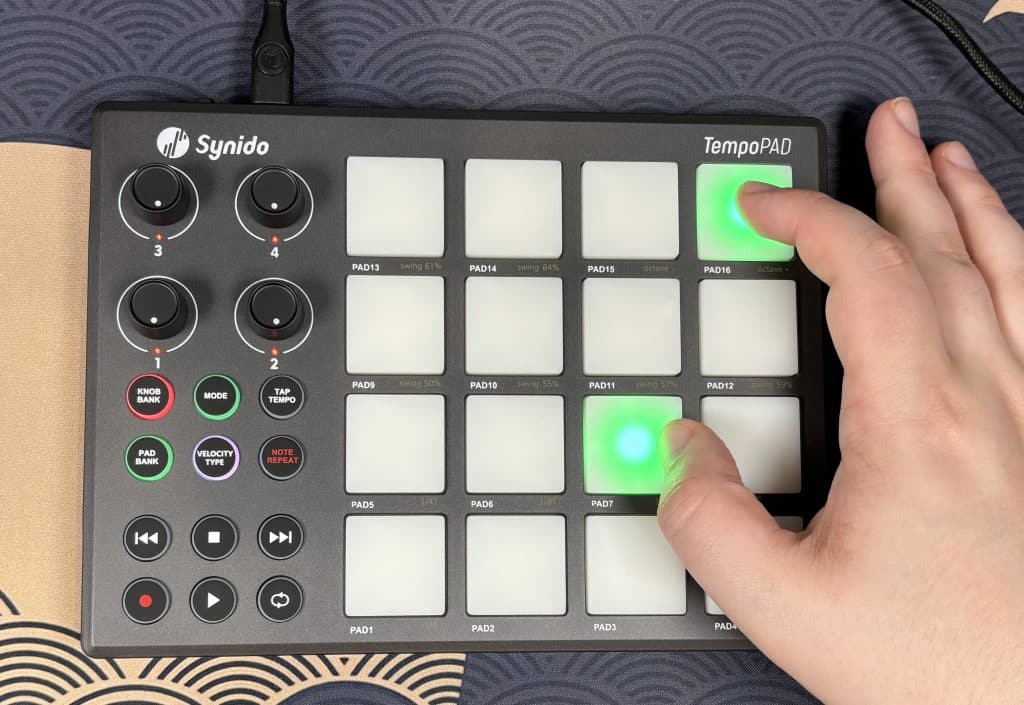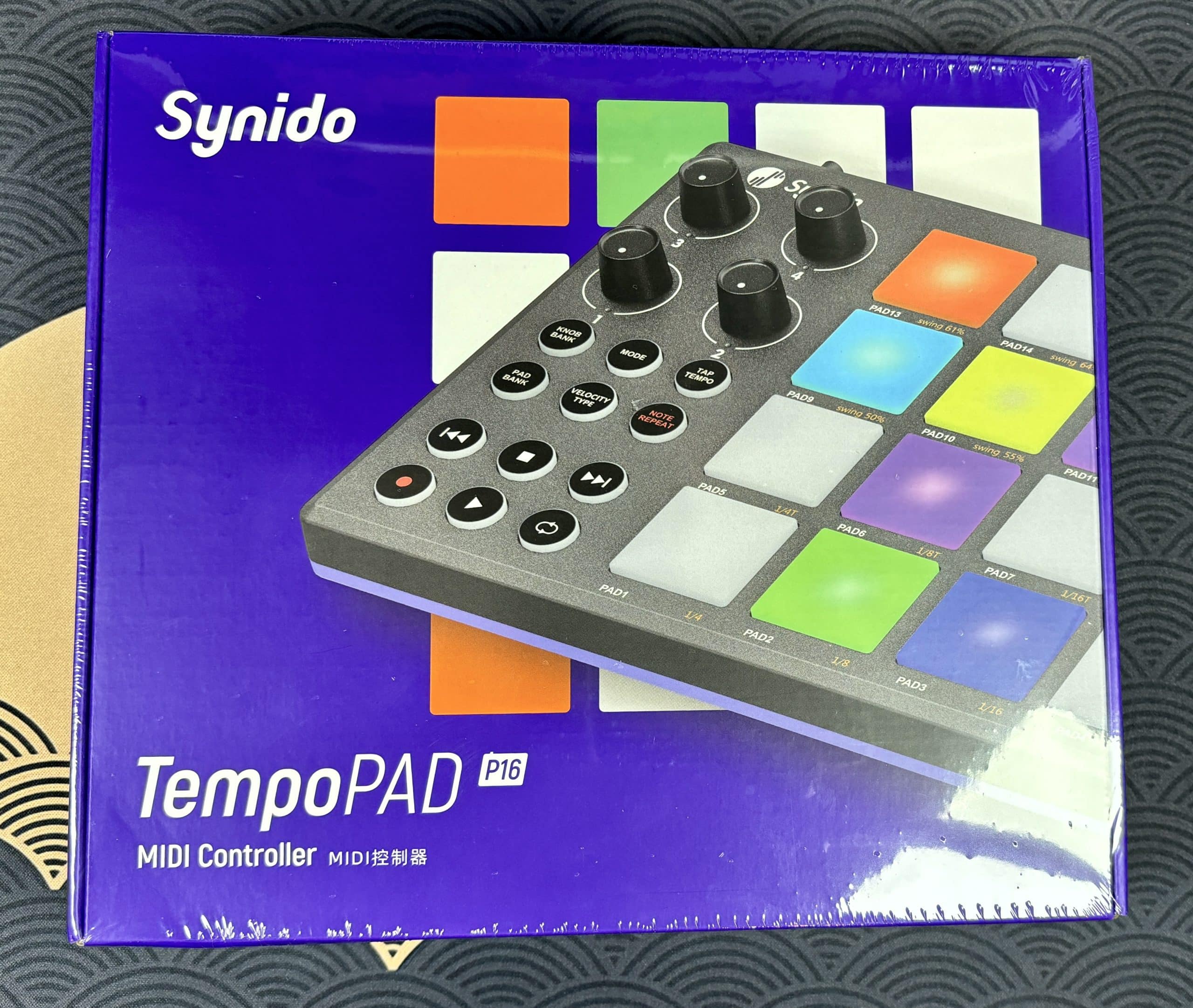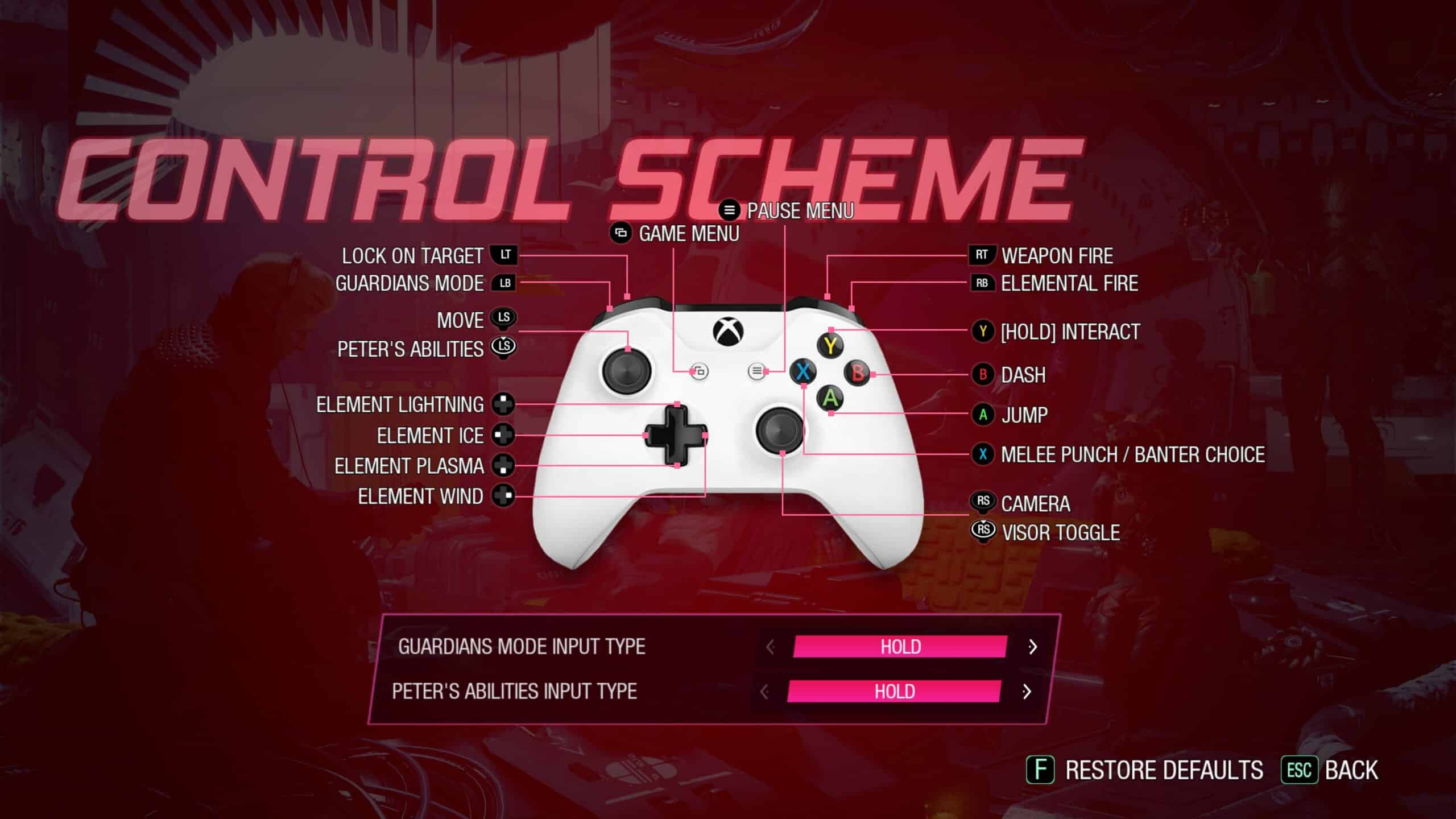The interesting thing about content creation is just how many options exist. Be it exciting commentary, great gameplay, insightful reviews, or just creating something that resonates with those around you. Among this wide array are MIDI controllers allowing users to create a wide array of sounds. One of the newest faces in this industry is Synido, a newer company trying their hand at a number of audio staples. Given the potential pitfalls, is it worth considering, or are you better off heading elsewhere.
Synido TempoPad P16 Review Overview
Unboxing
Synido continued with their interesting mix of traditional, and experiential packaging. On the front is the product name, what it is, along with a picture of the product itself. I like how the background utilizes the same MIDI controller pads to give it a more cohesive look.
On the back is a small overview of the key features, including six transport buttons, computer software, included ports, four potentiometers, and 16 “velocity and pressure sensitive” pads with RGB backlights. Inside is a foam insert securely holding TempoPad and all its accessories.
Accessories
With TempoPad is a USB-A to USB-C cable, a 1/8″ TS to 5 pin Female DIN converter, manual and canvas zipper pouch. I love that it includes the converter, as this is can be a couple dollar expensive for those who lack one, and a welcome back up for those that don’t.
I also wanted to briefly touch on the “canvas” zipper pouch. Despite being described as such, it feels much closer to neoprene, a material commonly used in computer sleeves. It feels identical to that with a shape that fits the TempoPad perfectly.
In addition to offering a perfect fit, it has a cute set of designs. On one side has modest branding with the company and product name, and a simplified image of TempoPad. On the back is a more expressive design featuring upbeat statements like “grab your idea and never let go.”
Design
Synido opted for a simpler design with TempoPad. The body itself is plastic with a matte feeling finish. I say matte feeling, as it’s a matte finish that has some imperfections. Simply running my finger across it reveals various points and bumps that change the overall texture.
On the bottom is Synido’s usual purple color with the entire bottom section having an anti-slip silicon. I actually really like the way they did this, as there are dedicated feet like most devices, they’re just made into part of the design. Basically the corners are raised with a slight incline giving it a cohesive look. The same is true when it’s lying flat, as there is a subtile hint of purple to give the otherwise black electronic some much needed flare.

After a couple hit/miss designs, I am happy to see all of TempoPads connectors are on top. This makes it a lot easier to hide cables, and other elements. The only downside is the power button is also located there and works like pen. Clicking it once locks it into the powered state, and clicking it again causes it to raise a little higher and turn off the device. In practice the cables will present accidental power presses, though I still dislike the potential being there.
Similar issues apply to the knobs/buttons. While each knob has 20 set positions, there isn’t a fixed start/end point. How much of this issue will depend on the use case, though I can confirm the range can be edited in the software to prevent it from being off and max.
Finally, I can’t say I am fond of the buttons. Everything on the left side of the board works like a traditional device. A firm press will engage whatever function that side is capable of. Hitting it just the wrong way can cause the button to not engage, potentially throwing off your beat, and a long press (1 second or more) seems to void whatever press you’re trying to make. This is nice in the event of an accident, though it makes some things feel cumbersome for me to use.
As for the pads themselves, they’re in an unusual place. There isn’t much of a push sensation to them. They just kind of accept a bit of force before activating. This can feel weird, not that it will change anything in practice. I couldn’t lightly tap it to trigger a sound, but I could purposefully interact with specific inputs whenever I wanted to.
Software
To help make the most of TempoPad, Synido created a rather robust software to help customize it to whatever specifications one might have. This is through a wide variety of settings and options to create the ideal sound.
On a basic level the software is set up in an understandable way. The look largely mirrors how TempoPad is set up, with tabs to indicate different arrangements. Through this organization is pretty straightforward, it’s understanding the options that take some time.
Windows Application
With knobs owners can edit the range of control they have. This helps correct the aforementioned design concerns. They can also be changed from Control Change (CC) to channel aftertouch, and pitch bend. All of these are clearly marked, it just requires editing the tab. Similar options exist for the play buttons as well.
The remaining options control the sound each MIDI button makes. These can be manually entered, or auto populate through fixed parameters. The actual function can be edited, along with most details. It’s something I don’t think will resonate in beginners, and will require a once over of the included manual to get the most out of it.
iOS Application
Where I want to give Synido a lot of credit is their mobile application. On the official website it mentions support for Mac, PC, and Android, but an iOS version also exists. This, unfortunately, requires a physical connection. I can confirm iPhone 15 works, though no clue on Lightning devices.
Nothing about the software is really different in the grand scheme of things. It looks, acts, and functions the same way. Outside of navigation, which I found easier, I’d consider it a direct copy. Even if it won’t make setting up TempoPad any easier, it allows for instant changes without having to rely on a computer.
Performance
On a basic level performance hinges on how well you understand MIDI controllers and music in general. Those without that understanding will have a large uphill battle, whereas those with it will likely enjoy what Synido offers.
When I was using TempoPad I didn’t have any issues getting the core experience down. I could make a beat, loop it, add to it, and keep doing so to produce some interesting beats. As I got more confident in the arrangements I was pleased by how powerful the controller actually is.

I can quickly make something, test it out, start editing, and use the play/pause buttons on the device to control my computer. These small touches are not on every device, and invaluable for someone with limited space, or wants to further streamline their creation.
Even if I wasn’t particularly fond of how the pad buttons interact with my presses, I never experienced an issue. Each one worked as I’d expect, complete with a bright light to indicate it was pushed. The buttons are also sizable enough where my issue was more placement than hitting any specific input. Once this was down I was surprised by how much power this simple device offered.
Synido TempoPad P16 Review Verdict
TempoPad comes down to understanding the target market. This is simply not a MIDI controller I would suggest to a newcomer. It’s not the most user friendly, and expects a bit more than a beginner might have. However, someone with that background, or looking for a slight upgrade will likely be pleased. Not only does it have a lot of on device power, the function keys, and mobile phone app vastly increase productivity without over complicating things.
Editor’s Note: TempoPad P16 was provided to us for review purposes.















